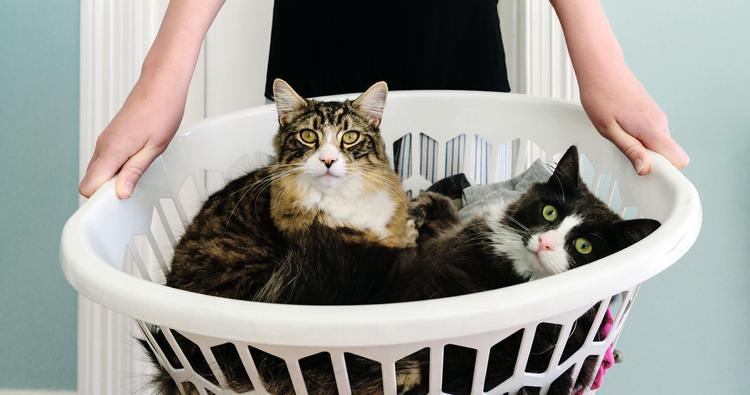Introducing a New Cat Too Soon: Troubleshooting Common Issues
Cat introduction process not going well? Here’s what might be causing the issues.
Cat introduction process not going well? Here’s what might be causing the issues.
by Katie Koschalk, | March 25, 2024

Chendongshan / Shutterstock
Many cat parents find themselves stumbling through the new-cat introduction process — and sometimes falling flat on their faces. Whether it’s due to getting bad advice, not following good advice properly, or rushing through crucial steps, a poor introduction can lead to conflicts that hinder peaceful cohabitation between cats.
In this article, we’ll share the proper way to introduce cats, highlight common mistakes, and provide strategies for getting back on track if things have gone off course. Before getting into the nitty-gritty, let’s lay down some basics.
The introduction process begins the moment you bring a new cat into your home. From that point forward, every interaction will shape the dynamic between your new cat and your resident cat.
As for when to introduce cats face-to-face, Stephen Quandt, a certified cat behaviorist and founder of Stephen Quandt Feline Behavior Associates, LLC, says the first mistake people make is assuming there’s a timeline. The speed of a successful introduction is set by the cats — it could be weeks, months, or never, Quandt says.
The second major mistake cat parents make during this process is letting their cats meet too soon. Maybe you thought they were ready, or perhaps you just wanted to get the process over with. So you rushed it a bit. This can lead to a range of negative outcomes, primarily stemming from the cats’ territorial instincts and the stress of sudden changes in their environment. Some potential consequences of a rushed introduction include:
Aggression and conflict: Cats are territorial animals, and introducing a new cat too soon can trigger aggressive behavior as they vie for dominance or defend their territory. This can result in fights, injuries, and ongoing hostility between the cats.
Stress and anxiety: Cats thrive on routine and familiarity, so introducing a new cat too quickly can cause stress and anxiety for both the resident cat and the newcomer. This can manifest in various ways, such as hiding, excessive vocalization, decreased appetite, and even illness.
Failed integration: Rushing the introduction process can result in a failure to establish a positive relationship between the cats. They may never fully accept each other’s presence, leading to ongoing tension and discord in the household.
Behavioral issues: Introducing cats too soon can contribute to the development of behavioral issues. You might notice litter-box avoidance, spraying or inappropriate urination, or excessive furniture-clawing due to stress and insecurity.
Long-term relationship strain: Even if initial conflicts are resolved, introducing cats too soon can strain their long-term relationship. Resentment or fear may linger, leading to ongoing issues with cohabitation.
Yes, hissing is one of many behaviors a cat may display in response to feeling threatened, frightened, or agitated. It’s a warning signal that essentially communicates “back off or else.” With that in mind, common mistake number three is not paying attention to (or properly interpreting) the cats’ behavior, and reacting to it when necessary.
Other signs of stress, fear, or anxiety include:
Vocalizations (usually a guttural, howl-like sound)
Lip-licking
Big, round pupils
Ears going sideways or back
Swatting
Lunging
Tense body-posturing
Raised fur
A fixed stare
A puffy tail
Arched back
Fur standing up on end
Trying to flee the area
All of the above signs, including hissing, indicate that your cats are not ready to move forward, and you need to slow things down. (More on this shortly). Quandt suggests thinking of the introduction process like a bank account: Positive interactions put money into the account (i.e., build trust and comfort between the cats), while negative interactions take money out of the account (i.e., undo positive progress).
Below are the three crucial steps for introducing a new cat to a household that already has a feline. Remember, the cats determine the speed at which you progress through the introduction process. You should only move to the next step of the introduction process if your cats are displaying positive signs (as detailed in the next section).
Confine your new cat to a single room — ideally one on the smaller side, like a bathroom, office, or small bedroom. The room should be equipped with essentials like a litter box, food, water, toys, scratching pads, and a cat bed.
Feed the cats on opposite sides of the door to this room, gradually moving their dishes closer with each meal. The goal is for the cats to associate the pleasurable activity of eating with the other cat’s presence. Continue this process until both cats can calmly eat with both bowls directly on each side of the door.
A couple of important notes:
Not all cats react well to eating near the barrier. Says Quandt, “Eating is a survival mechanism, and as a result, some cats become stressed by eating near the other cat.” If this is happening, don’t use food as a tool. Instead, try playing with or petting each cat on either side of the door.
If you’ve adopted your new cat from an environment where they might have been exposed to illnesses, such as the street, and they haven’t undergone a veterinary evaluation yet, do not let your new cat come face-to-face with your resident cat. (Through the door is fine.) Take your new kitty to your vet to ensure they aren’t incubating contagious illnesses — such as parasites, FeLV (feline leukemia) and FIV (the feline equivalent of AIDS) — before proceeding to the next steps.
Swap sleeping blankets (or other items saturated with the cats’ scents) between your new cat and your resident cat by placing the blankets in each other’s spaces. Sprinkle treats or catnip on each blanket to create a positive association with each other’s scents.
Use two doorstops to prop the door open a crack, so they can see each other (but not touch) as they eat. Repeat the feeding process, inching the bowls closer to the door until they can eat calmly directly on either side of the door. Another option is to install a baby gate in the doorway of the sanctuary room and cover it with a blanket. The blanket can be incrementally raised to gradually increase visibility between the cats.
Next, let the cats explore each other’s spaces for a few hours (while keeping them physically separated through a closed door).
If both cats are showing promising signs of socialization, open the sanctuary-room door and allow the two cats to meet. Carefully monitor their body language. If they display any negative behaviors (hissing, swatting, growling, etc.), Quandt suggests immediately putting the new cat back in their sanctuary room, and back-tracking the introduction process (i.e., restarting the feeding process on opposite sides of a cracked door or covered baby gate).
However, if things go well during that meeting, allow the cats to socialize for 10 minutes, and then separate them again. Gradually increase their visiting time each day.
How do you know if things are going well? Here’s what to look for:
Relaxed body language: Cats that are comfortable with each other will display relaxed body language, including ears in a neutral position, a relaxed tail in a loose position (either up or mid-way), small pupils, and a loose posture. They may lay down, groom themselves, curl up for a nap, or just mind their own business without giving the other cat much attention.
Curiosity and interest: Sniffing at the door, sniffing each other, or exhibiting relaxed body language while observing each other suggests they’re open to forming a connection.
Playfulness: Play behavior, such as batting at each other’s paws under a door or engaging in gentle chasing, can indicate that the cats are becoming more comfortable with each other, and are beginning to see each other as potential playmates.
Sharing spaces: As the cats become more accustomed to each other, they may start to share common spaces without tension or conflict. This could include lounging in the same room, eating close to each other, or playing close to each other without signs of anxiety or aggression.
Affection: While you shouldn’t expect affectionate behavior right away (or ever), some cats do become friends quite quickly. This is evident by mutual grooming, touching noses, cuddling, sleeping together, headbutting, or rubbing against each other.
Introducing cats requires patience, observation, and careful management. Here are some key tips to guide you through this delicate process.
If there’s one takeaway you get from this article, it’s this: Don’t rush the introduction process. It’s essential to allow the cats to acclimate to each other gradually on their terms — not yours. Rushing the process can lead to fearful reactions, which can at best, delay the process, and at worst, create permanent conflict between the cats.
If you notice signs of tension or aggression between the cats, don’t hesitate to take a step (or two) back in the introduction process. Revert to the previous step where the cats were comfortable, and go from there. If fear and aggression persist even after reverting to an earlier stage, continue stepping back until they chill out again, even if that means going back to square one.
Quandt suggests you ensure the environment is conducive to peaceful coexistence. Ask yourself questions like:
Are there ample escape routes for both cats?
Have I provided enough litter boxes (one per cat, plus one extra)?
Do they both have access to food and water?
Have I provided enough climbing trees and scratching posts?
Are there any locations where a cat might get cornered and be unable to escape? If so, how can I block these areas off?
Optimizing the environment can minimize stress and territorial disputes between the cats.
If you’re struggling with the introduction process despite your best efforts, don’t hesitate to seek help from a professional cat behaviorist. They can provide expert guidance and support tailored to your specific situation, increasing the likelihood of success. You might even consider hiring a behaviorist before you bring your new cat home, so they can help you create a solid game plan.
With proper introductions and a suitable environment, most cats can at least learn to tolerate each other — and some might even become friends. But that’s not a guarantee. Despite your best efforts, some cats may never get along. In these cases, the new cat might need to be rehomed, or you may need to keep them separated within your house.
If you've done all you can, it’s important to remember that pets are individuals, and your home might not be the right fit. If you’re considering finding a new home for them, check out Rehome. It’s Adopt a Pet’s program that lets adopters safely adopt a pet directly from a cat’s current pet parent or caretaker. This helps pets find new, loving homes without entering a shelter.
Introducing a cat to a dog requires careful planning and supervision. Start by keeping the cat in a separate room. Gradually introduce their scents through items like blankets or toys. Once both animals appear calm and curious, supervise a meeting with both animals on leashes.
Avoid forcing your cat out of hiding. This will only increase their stress and fear. Provide your cat with all the essentials they need (food, water, toys, treats, a cozy bed, etc.), and let them come out when they’re ready.
The time it takes for cats to get along varies greatly. Some cats may learn to coexist peacefully within a week or two, while others may require several weeks or even months to adjust and accept each other.
Make sure you have all the necessary supplies for your new cat to initiate a smoother introduction process. This includes another litter box, food and water bowls, a scratching post, a cat bed, more toys, a cat carrier, and a collar with an ID tag. You can find a complete list of supplies you’ll need here.
According to Quandt, it’s never appropriate to crate a cat during the introduction process. Doing so rushes the introduction process and forces the crated cat to interact with the loose cat without any means of escape or hiding. This can create fear that hinders the process and may lead to long-term conflict between the cats.

Katie Koschalk is a freelance writer based in Northern California. Fusing her love and knowledge of animals with her journalism degree and years of professional writing, Katie is dedicated to improving the lives of pets and their caretakers by sharing helpful and accurate information. When she’s not at her desk, you can find her exploring trails with her Aussie, Hunter, cooking plant-based meals, and talking to her two cats, Jax and Sadie, in really ridiculous voices.

Behavior & Training

Behavior & Training

Adoption Advice

Adoption Advice
Are you bringing home a new kitten? Find out the best way to introduce your new kitten to your crew.

Adoption Advice
Adopting a new kitten? We've created a checklist to help you get organized before bringing your new friend home.